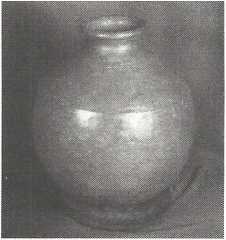Talk:Ghatam
ghaṭam
Indian music, though originally one, gradually branched off into two systems:

the North Indian (Uttarādi) and the South Indian (Dakṣiṇādi). The South Indian clas¬sical music retained its original flavour whereas the North Indian system attained a distinctness of its own due to the Persian influence wrought during the Mughal period. Among the percussion instruments used in the South Indian classical music —vocal or instrumental—the mṛdaṅgam is the most important. The next in importance is the ghaṭam. It is actually a large earthen pot carefully prepared so as to give a musical sound when beaten, with the finger-tips and palms of the hands. Unlike the mṛdaṅgam, the śruti or the tonic of the ghaṭam cannot be changed. Hence, the player of a ghaṭam generally keeps a large number of them to suit the different śrutis of the singers.

